An isthmian metropolis wedged between a large freshwater lake and the Puget Sound, Seattle is a city of canals, bays, inlets, hills, valleys, and a wealth of bridges that help residents traverse some rather challenging topography. Bridges are a way of life and a source of both pride and angst in Washington’s largest city, and there are some notable ones: Several historic double-leaf bascule bridges, record-breaking floating bridges, ravine-spanning arch bridges, a tideland-spanning concrete viaduct, a freeway-carrying double-deck steel truss bridge, and a 1930s-era cantilever and truss bridge with tragic associations and a troll residing beneath it.
Matthias Olt, a design director for the Toronto-headquartered B+H Architects who is based out of the firm’s Seattle studio, believes that there’s room for another marquee bridge in Seattle unlike any built before. He has proposed a long-span bridge built from mass timber and steel to replace the indefinitely closed West Seattle Bridge, a nearly 3,000-foot-long concrete segmented cantilevered bridge that links peninsular (and largely residential) West Seattle with the rest of the city. Completed in 1984 to replace a drawbridge damaged during a maritime collision, the West Seattle Bridge carries seven lanes of traffic across the Duwamish Waterway and Harbor Island at the Port of Seattle and is a crucial transportation link as the city’s most highly-trafficked arterial bridge.
The West Seattle Bridge has been closed to all traffic since March 23 after growing cracks were discovered in the underside of the structure amidst the coronavirus pandemic. In July, Seattle Mayor Jenny Durkan declared the wildly disruptive (and costly) crisis a civil emergency. Several months on, the ultimate fate of the West Seattle Bridge remains undecided as a special community task force weighs replacement and, less feasibly, repair options. As the Seattle Post-Intelligencer recently reported, a “rapid” steel replacement option proposed by engineering firm HNTB is also now on the table.
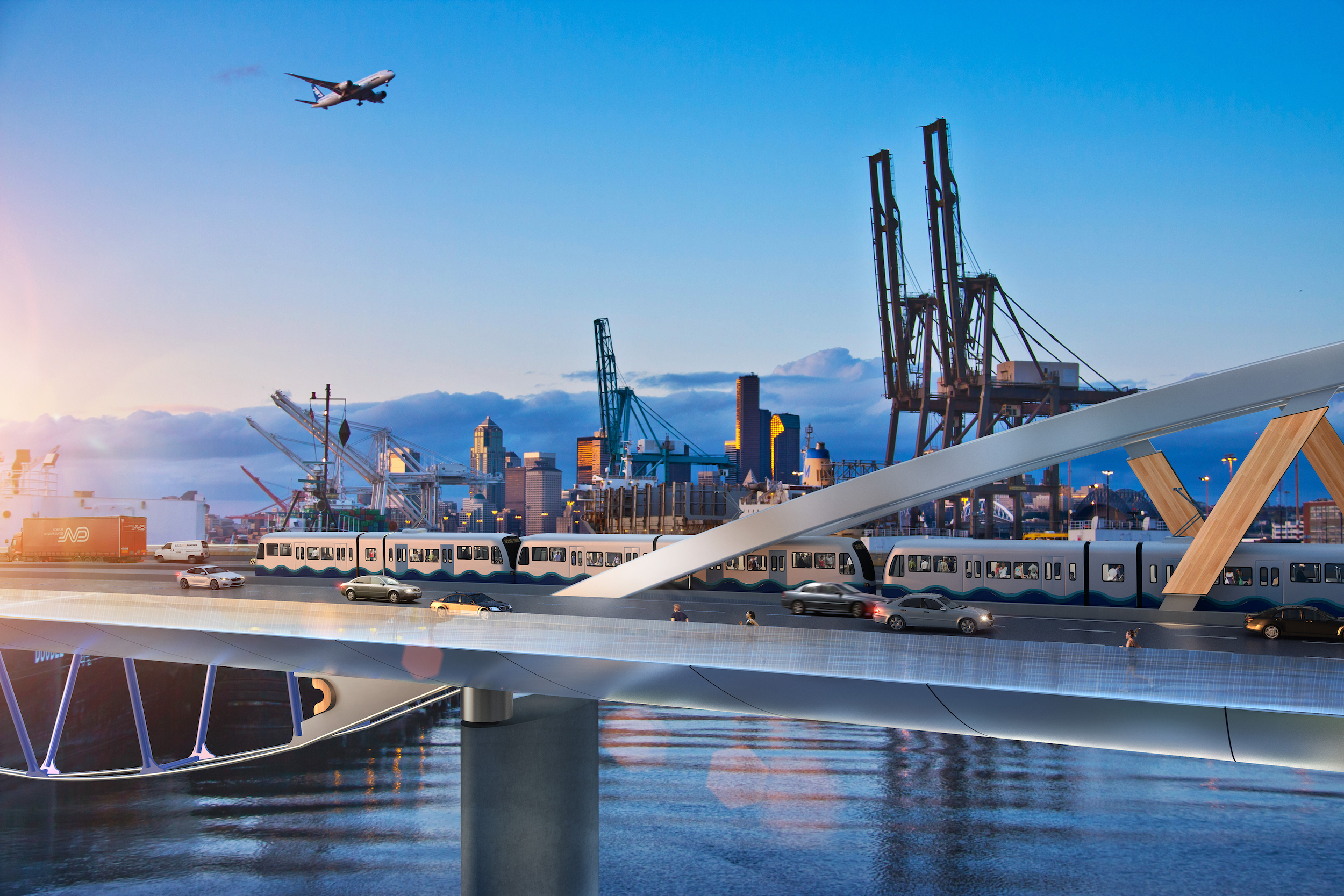
In the meantime, an official announcement from Durkan regarding the matter, which was due to come earlier this month, has been delayed. More recently, an 89-page cost-benefit analysis report detailing seven options, including two repair scenarios and a tube-tunnel (but not the rapid replacement option that’s been garnering attention as of late), was released earlier this week.
“The anticipation is that the repair option will not be considered because it doesn’t meet the economic benefits that one would suspect if you just put a Band-Aid on versus replacement,” Olt explained to AN. German-born and educated, Olt is a mass timber expert who received an AIA Seattle Honors Award in 2017 for conceptual plans for a tall mass timber residential tower (while with CallisonRTKL) and speaks frequently on sustainable design.
“It’s in the double-digit millions,” he added, noting that because it’s unclear how long a repair would even last before a new bridge is necessitated, “the margin of the unknown is so large that it would not be prudent to opt for repair than replacement.”
A towering list of benefits
Not on the proverbial table is the B+H proposal for a timber hybrid replacement bridge. However, the buzz around such a structure has generated productive conversations locally and further afield about the largely untapped—in the United States, anyway—promise of long-span vehicular bridges built partially from wood. As noted by the Puget Sound Business Journal, the firm submitted the proposal to the city as more of a “conversation starter rather than a formal response to their request for qualifications.” Although engineered wood is an unconventional material for major bridge construction, the Pacific Northwest is somewhat of an epicenter of mass timber construction with both Washington and Oregon allowing wood buildings up to 18 stories high.
It doesn’t hurt that many Seattle residents are keen on the idea of a mass timber bridge, with hundreds signing a Change.org petition sent to the Seattle Department of Transportation (SDOT) in support of the proposal, which is outlined in an 11-page document, published by B+H in collaboration with sister companies SMEC and Robert Bird Group, that quotes Buckminster Fuller, gets into the nitty-gritty of mass timber-steel composites, and envisions a new West Seattle Bridge as “a functional, beautiful monument to the innovative and conscious populace it serves.”
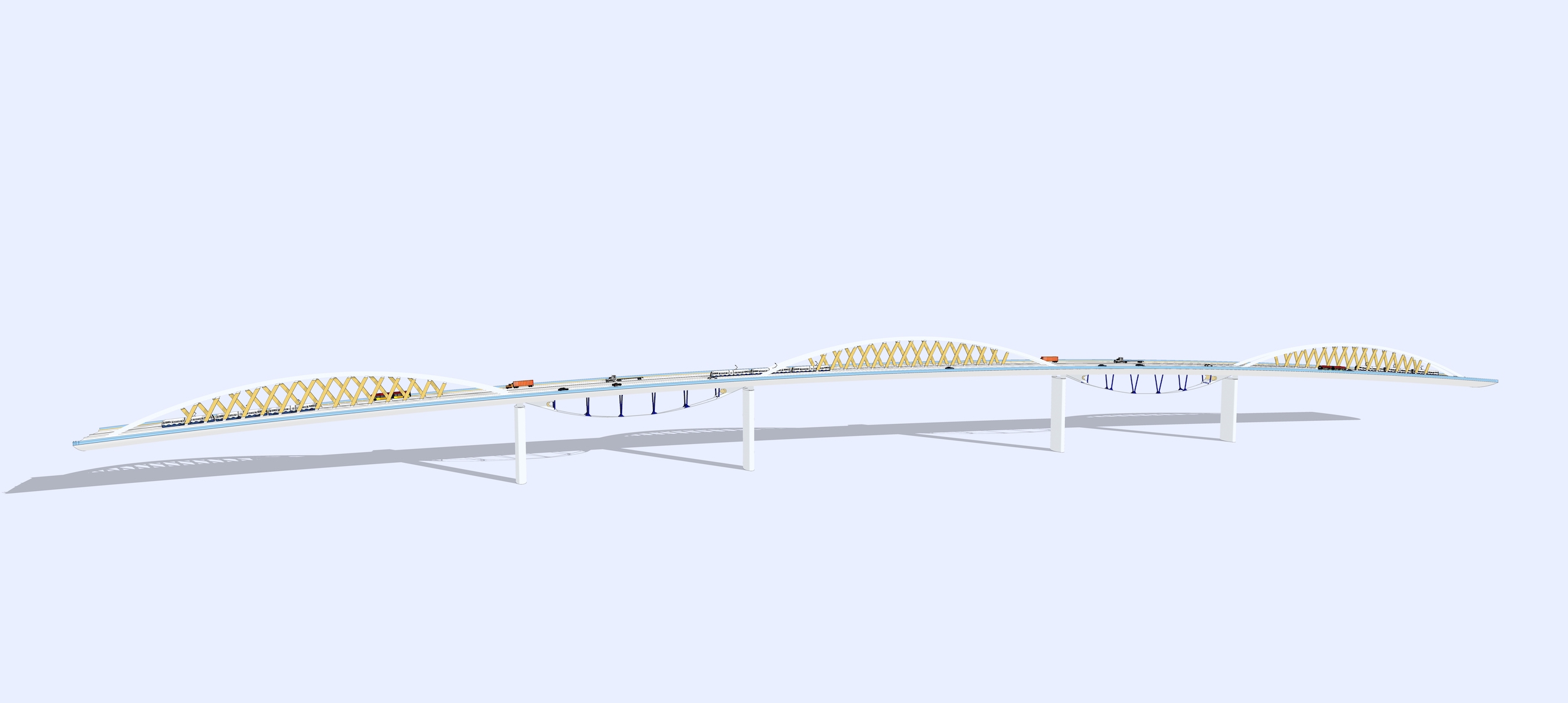

The document lists the numerous key advantages—some of them obvious to those familiar with mass timber construction—of replacing the current West Seattle Bridge with a hybrid mass timber-steel structure: Carbon sequestration, a 100-year-plus lifespan versus 50-to-75 years for a concrete bridge, a condensed construction period due to prefabricated elements that balances out the higher cost of timber, the potential to reuse the existing foundation due to the lightweight nature of the structure, repair needs that are safer and easier to detect and execute, and on.
The bridge proposed by Olt takes the form of a conventional arch bridge with steel plate compression arches and five-foot-wide hangers made from a wood-steel composite or wood-carbon fiber composite that would “create a unique aesthetic and texture on the bridge, and there is an idea that mass timber-steel composites can reduce the stress range in the hangers and potentially improve their fatigue performance” according to the proposal.
The biophilic effect
It’s some of the less immediate and non-technical benefits of a mass timber replacement bridge for West Seattle that are perhaps the most fascinating and could have the most wide-ranging impact.
As Olt pointed out, a singular bridge that incorporates a renewable building material and sports a dramatically lower carbon footprint could serve as a new source of bridge-related civic pride for Seattleites and help mend the psyche of a historically resilient city that’s had somewhat of a particularly rough go of it in 2020—which is saying something all considering.
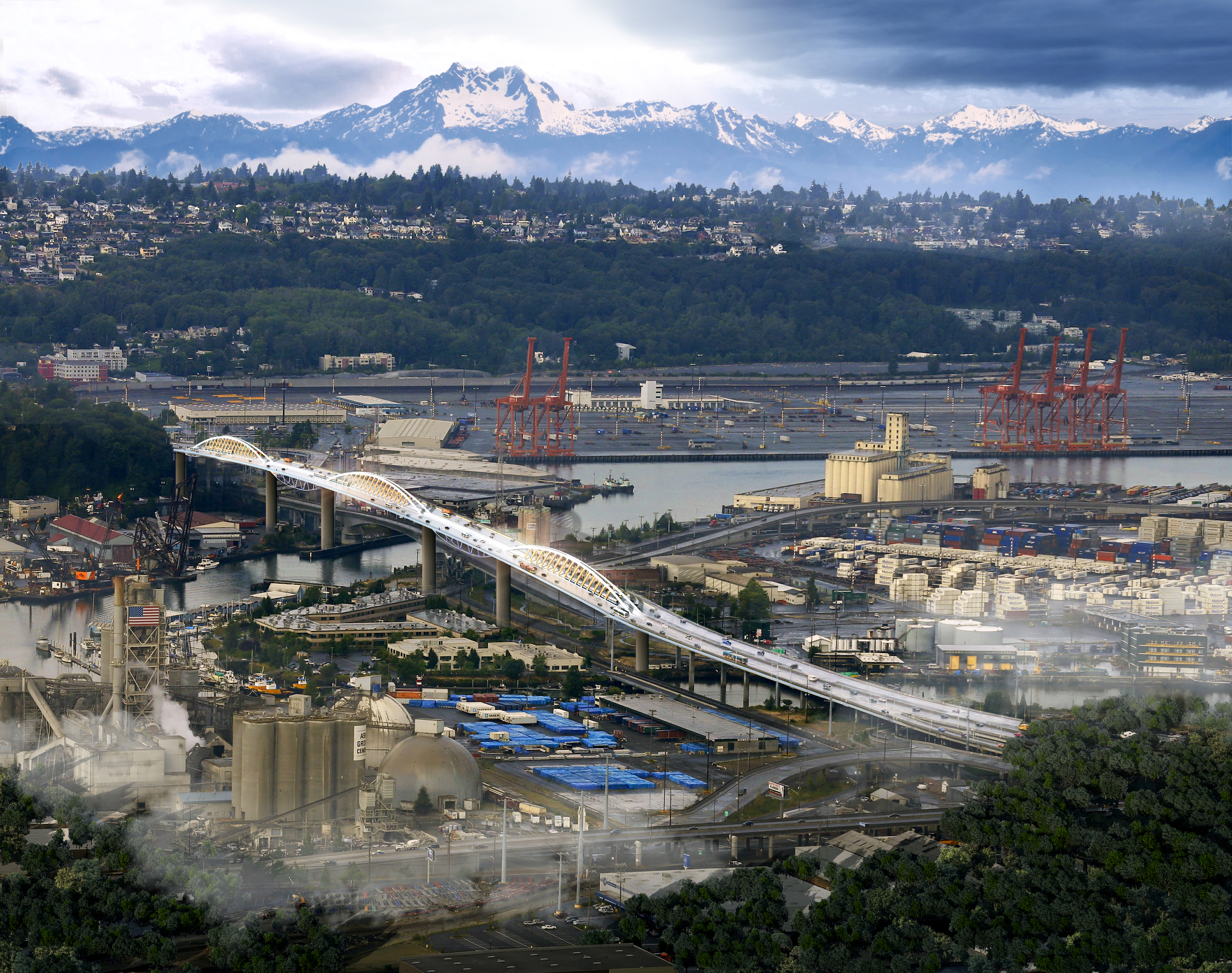
Relatedly, Olt believes that a mass timber project of this magnitude could help to revive Washington’s fading timber industry and create new jobs within a sector that historically dominated the region.
“For a community like Seattle which prides itself on being progressive and forward-looking and cherishes the natural environment, there’s a two-fold opportunity,” said Olt. “There’s the sense of pride and there’s the opportunity to tie this to the timber industry in Washington state, which has been lagging since the 70s or so.”
There’s also, as Olt explained, other benefits of mass timber beyond local pride and regional economic growth include biophilia, which Olt noted is “closest to my heart.”
“There’s scientific research that suggests the view of wood around you regulates and reduces your heart rate, and even affects your sleep-wake cycles,” said Olt, noting that he is a “firm believer” in the healing properties of biophilic design. “So, what happens to a community—the West Seattleites or the other side—as they pass this bridge? What does it mean for health and well-being and the whole psychological and physiological composure of people?”
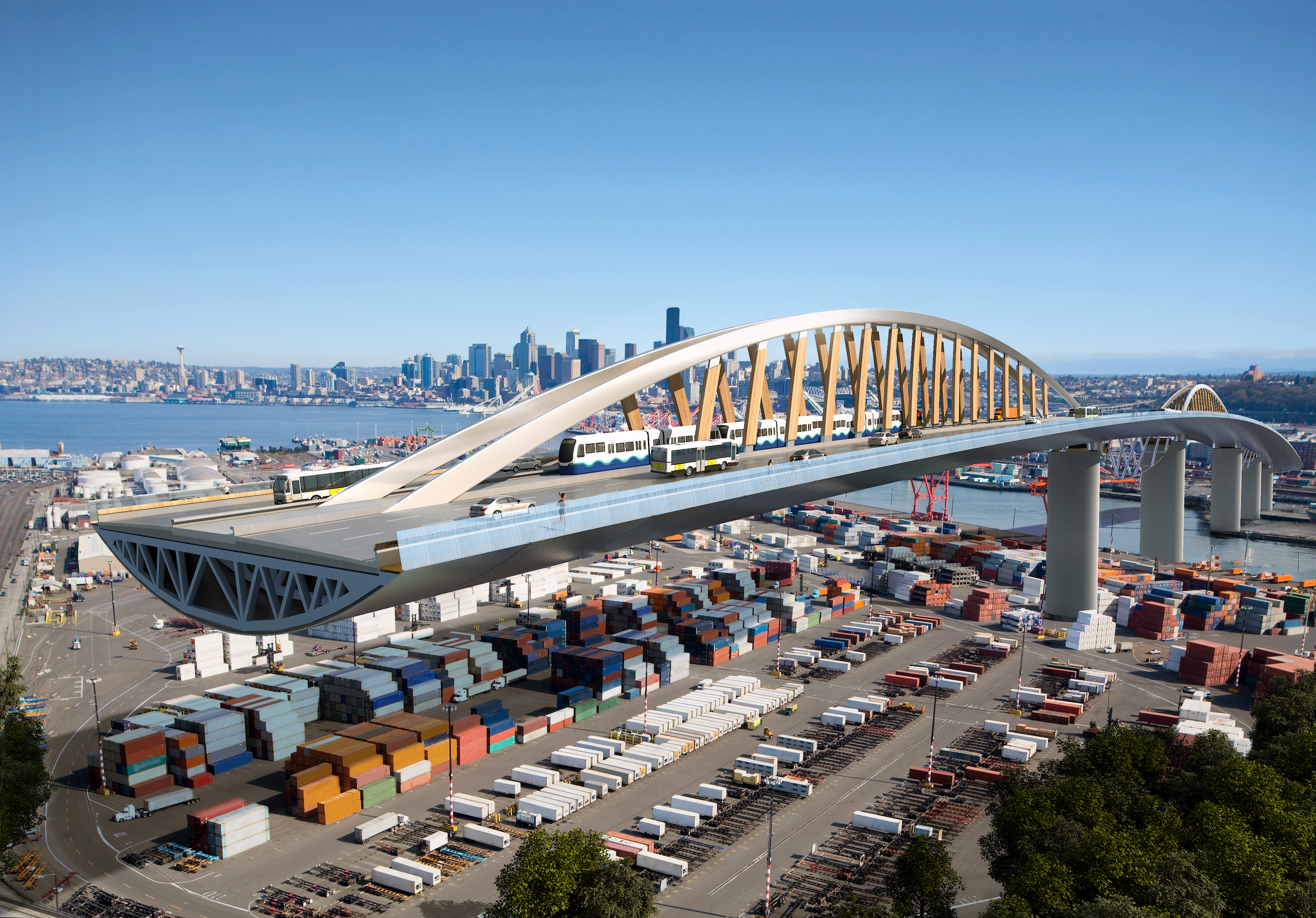
Goodbye traffic lanes, hello high-rise park
Adding to the bridge’s wood-derived calming beauty is a high-rise park that could eventually comprise roughly half of the space once reserved for vehicular traffic. Designed to accommodate pedestrians and cyclists, additional space would also give way to future mass transit rail service into West Seattle. This will be a reality sooner than later as Sound Transit expands its Link light rail network. (A nearly five-mile extension linking downtown Seattle with the Alaska Junction neighborhood in West Seattle is in the initial planning phase and could be completed as soon as 2030 if the current timeline holds.)
As envisioned by Olt, the park element would come later as West Seattle residents become more reliant on mass transit, ride shares, and other more sustainable modes of transportation and less on privately owned cars. One day, the West Seattle Bridge, which before it closed carried an average of 100,000 daily vehicles, could experience such a low traffic volume of traffic that its primary function as a vehicular bridge would be rendered semi-moot and some of its width could give way to new usages like a community-benefitting public park. “I believe that there’s a social equity component that goes with it,” said Olt. “We know how precious parks and places of nature in urban cities are.”
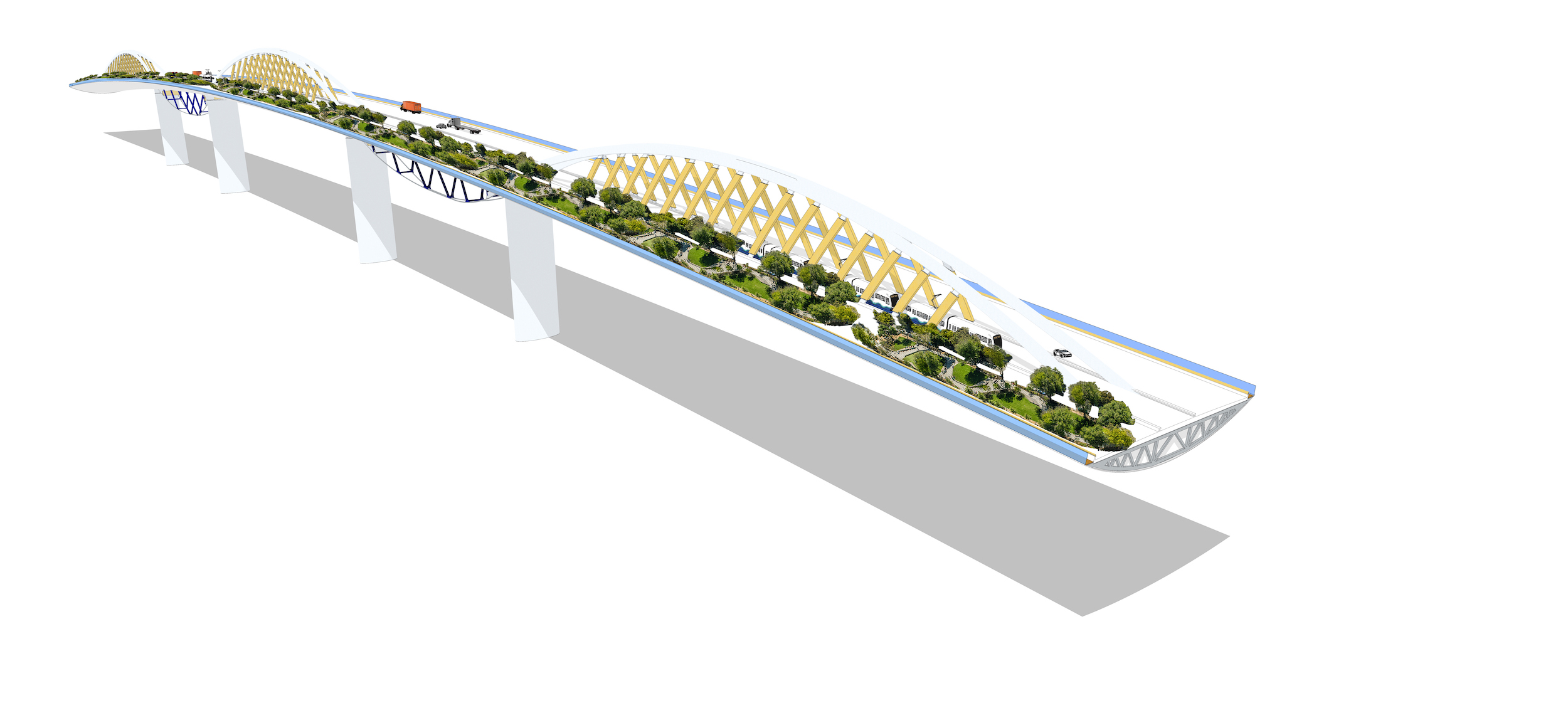
And as pointed out by Olt, the “breathtaking” views of the city (downtown Seattle is just to the north), Puget Sound, and the surrounding mountains from a multi-modal park-bridge spanning the Duwamish would be something to behold.
Major mass timber vehicular bridges carrying major roadways, although non-existent in the U.S., aren’t completely without precedent. Completed and approved examples noted by Olt include bridges in Quebec, Norway, Finland, and the Netherlands.
While a hybrid mass timber replacement for the West Seattle Bridge isn’t under consideration by SDOT at the moment, it’s not entirely unlikely that the Seattle area could join the above list of locales in the not-so-distant future. (From a regional perspective, British Columbia is a few steps ahead.) As other Seattle bridges, many of them aging, start to require serious repair and potential replacement, mass timber could very well be considered. Olt, through his advocacy for and expertise in mass timber construction, has planted a seedling that could very well pave the way for another Seattle span like no other.










